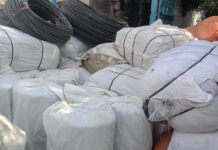One of the key tasks in developing a business strategy is to identify and separate what is relatively predictable from the fundamentally uncertain. Future scenarios are built by varying the uncertain while keeping the predictable constant. Of course, if there is nothing which can be predicted then there is not much use for strategy or any sort of planning.
In this ongoing heated debate between various stakeholders on lockdowns-versus-opening the economy since Covid-19 appeared as a major disruption in our lives, we seem to be dealing mostly with the unpredictable, with some exceptions.
For those whose livelihoods depend on business, it is natural to want the economy opened as soon as possible to prevent financial destruction, which is already imminent for many.
However, conducting business requires both supply and demand to exist at the same time. You have a product or service to sell. Someone else needs or wants to buy it. In the current circumstances, when businesses want to open the economy, they want the supply side to be opened, for their factories, offices and shops to be allowed to operate.
But the current situation is not and has never been a supply-side issue, it is a demand problem. The fear of this virus has, for all intents and purposes, killed the demand for most products and services. From crude oil to schooling, to eating out to travel, and to shopping and so on. Demand is dead, hence the unpredictable situation.
In fact, this is probably the first time the world has collectively seen such a drastic collapse in demand. With the exception of essential food and healthcare, it is difficult to find a sector where demand has not been disrupted. In order to open up the economy, the demand has to return.
But how does demand reappear and assume its pre-Covid-19 levels? That can only happen when everyone feels safe from the disease. When we can return safely to schools and offices, take public transport or eat at restaurants, go shopping or travel. That is when demand will return. Can that actually happen without a vaccine being developed? Even if a vaccine becomes available tomorrow, it will take a while before all countries in the world acquire it.
As the refrain goes that one often hears in the media, “We will not decide the timing. It is the virus that will decide.”
What is clear is that a decisive and predictable economic recovery depends on a medical solution — when medical science has successfully identified and contained the virus, treated illness and created immunity throughout the world. Until then, we will remain in these cycles of hard and soft lockdowns, opening up, seeing infection numbers surge and locking down again.
This is a pattern we are all likely to become familiar with. In fact, if this pattern continues for a year, will it not have created a new normal, and in doing so have fundamentally changed life? Perhaps, but let us not get that far ahead.
What science is making amply clear is that Covid-19 is not “an event”. It is unlike other disruptions we have seen in the past, that have defined generations — 9/11 or the 2004 tsunami or the 2005 Kashmir earthquake or Hurricane Katrina in the USA, 2005. The coronavirus pandemic we are seeing today is more like a ubiquitous phenomenon — like the advent of the internet which has changed life over the last 30 years in more ways than we could have imagined.
And just like everything else, the world of business must also accept the multitude of uncertain elements in this situation. But what do businesses do then? Unfortunately, the predictable yet bitter pattern is that a lot of current businesses will suffer badly and may not survive — at least not with the business model they were operating before Covid-19.
Governments are trying to mitigate the situation by providing loans, tax reductions, employment grants etc. But how long can this continue?
In the business world, hoping for a miracle is a bad strategy. Hence, we will see many closures and accompanying layoffs. These moves will be much more visible in the small and medium enterprise sector. In the corporate sector, those who have been successful over the years — mostly big companies — have built up enough cash reserves. They would be well advised to conserve as much of this reserve as possible. However, this should not mean automatically laying off employees.
In fact, the strongest predictor of future success for these companies is to retain employees and contribute in this way to the fight against the virus. If they can emerge from this crisis with solid reputations, that will be a big achievement.
But that will not happen if they are perceived as lobbying with governments to try and obtain benefits for their industries while laying off employees as a first line of defense. Even if they do influence governments successfully, they need to remember that governments don’t create demand — at least not under the economic system that currently rules most of the world.
It’s not that change like this, in demand patterns, does not come with its own set of opportunities. The entrepreneurial-minded who are willing to consider that the new normal is already here might evaluate investment in sectors in which demand has stayed inelastic — and will continue to grow, hence be more predictable. No, I do not mean we should all start producing masks and sanitizers, although some have already embarked on that path.
In general, healthcare as an industrial sector should see massive public and private investment. Pharmaceutical companies, hospitals, laboratories and other related sectors should see strong demand right now and well into the future. Similarly, governments would do well to give renewed focus on agriculture and the food value chain and provide this sector with plenty of support and opportunities.
Education and online models of education were already seeing fast growth pre-Covid-19, but this sector will now grow even faster. And speaking of online, anything online and virtual is ready to take off at warp speed now. If we thought online interactions and products were growing fast before, just wait and see what happens in the next couple of years. Particularly in sectors like education, retail, banking and others.
Ultimately, a resolution of the medical problem is necessary to revive demand. Even when it does return, demand will be slow and gradual with many changes in how businesses are used to operating.
Instead of wishful thinking and expecting or hoping for the future to be a return to the past, it would be worthwhile for business owners to take the time to reflect on what sort of change their respective industries will undergo. This is not a bad time to start afresh, perhaps in new, emerging sectors or possibly even with new business models.
























Yet Mr. Asif our next 70 years look worse than the previous 70 based on the track we have chosen. There is no clear initiative or policy to back the local entrepreneur.
Well said. On a related note, I would like to highlight, in detail, one such industry that is really betting for things to return just like in the past. It is the Karachi real estate market. It is a cartel run by DefClarea – basically all the brokers and real estate agents operating in Defence and Clifton area ganging together to protect their commission and some of whom are hugely invested themselves in the property market in DHA and Clifton. They never let the property market go down even when there is no demand due to their own vested interests. Also taking 1% commission on 20 crore property from a buyer and seller gives them 40 lacs easy money on a single transaction. Why would they ever let prices go down?
So even in this pandemic, which has resulted in complete drop in demand and no transaction whatsoever, they are actually applying the same formula and instead of letting price go down to their actual value where demand and supply meet, they are as usual actually pursuing the strategy of gradually increasing the prices of apartments, houses, and plots in Defence and Clifton area. The standard rule is to increase on average Rs. 5-10 lac in property value after every month and never let a distress seller who needs cash to sell his property at lower prices. They either buy that chance deal themselves or to their confidential clients or convince the seller to wait, but they will die before letting that information come to public knowledge.
This is a huge game going on and anyone can just pick up property prices in Karachi DHA and Clifton 6-12 months ago and compare it from now. The agents are able to do that in Karachi only because of extremely limited availability of land and property in DHA and Clifton, which provides them perfect opportunity to hoard the area to control the prices. This strategy can’t be applied anywhere else in Pakistan due to abundant supply.
This has been going on since over 10 years now and noone is there to notice this illegal hoarding and cartel practice which has resulted in property prices going way out of reach of common citizens of Karachi. I’ll give some examples. A 500 yard plot in DHA phase 8, D cutting, was available for 60 lacs in 2010. Now you can’t find one even if you have 5 crores. So prices have increased almost 10 times in 10 years! In 2011, A 300 yard double story independent house in DHA phase 4 was available in 1 crore 50 lacs, now price of that same house is over 7 crores. Creek Vistas 3 bed apartment was available in 60 lacs in 2008, now it is also above 7 crores. These prices were consistently increased by agents every year and that same strategy has been applied even in this situation when there is no demand. The property value is now so high it can be compared to the prices in developed cities like Dubai and San Francisco!
They prefer to keep increasing prices even if there is no transaction as they make more on 1 transaction due to such high prices as they can take 1% commission each from both buyer and seller. Due to increase in prices in DHA and Clifton, prices in the rest of the city areas like PECHS, Gulshan, Johar etc automatically increase in value as there is massive shortage of good housing societies in Karachi which goes in favor of landowners.
It’s a shame that no Govt body is looking at this hoarding practice and keeping prices in check. We all know the situation in Karachi. Even the water is not available in the whole of DHA and gas availability is also an issue at many place. Yet whatever happens, these brokers are doing speculations and artificially keeping the prices way higher than the actual value. It’s a bubble that will burst one day, but till then, this game run by Defclarea will go on.
Thanks for sharing a valuable write up as many of us can just think but cannot express it. I’m hoping that our business owners may create opportunities to build up diversified future.
Thank you for sharing this very insightful article. I am interested in investing in real estate but not sure where to put my money. Can anyone tell me which communities offer discounts to overseas Pakistanis and have a proven developer. Thanks
how r u i am fine